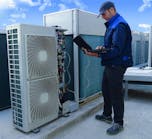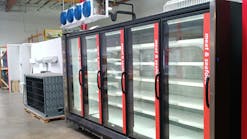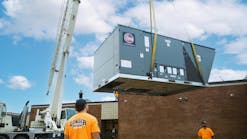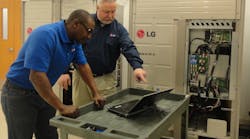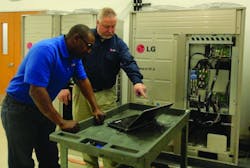Recent advances in VRF technology deliver architects, engineers, contractors, and end users ever-increasing efficiency, flexibility of application, whisper quiet operation, and comfort levels that were unattainable just a few short years ago. As a result of this new way of thinking in system design, a new way of approaching installation and service now exists.
Gone are the days of the old “rule of thumb” methods related to conventional HVAC systems. From load calculations to system layout, to installation and service, many long-standing industry practices have become obsolete. The full benefits of VRF technology can only be realized by changing the way we think about these paradigms. Just as technology has evolved, so have methods used to service and troubleshoot these systems.
This evolution begins with the installation of a VRF system. Long-term efficiency, comfort, and reliability start with proper installation of the equipment. While manufacturers may differ in their approach to the application and operation of their VRF technology, there is one area that all manufacturers can agree on: proper installation is key.
The installation approach is simple:
• Follow the designed system layout
• Wire per written specifications
• Keep piping clean, dry, and tight.
While these three steps sound basic, they are the cornerstone to long-term reliability, efficiency and comfort.
Start-up = Programming
Once the system is properly installed, the next step is to provide a proper system start up. This is where today’s technician first begins to experience the advances in technology offered by VRF equipment over conventional systems they’ve started in the past. Nearly all system setup can be accomplished at the outdoor unit, or at the indoor units through simple programming of remote controllers. The outdoor unit has the capability to automatically count system components, assign addresses, calculate connected capacities and verify pipe lengths. Onboard logic at the outdoor unit combined with sensors throughout the piping system allows the majority of the system startup to be accomplished from a central location, with far fewer tools and instruments than needed with conventional systems.
PC-based Commissioning
Each major VRF manufacturer provides a service and commissioning tool that is typically PC-based. By simply connecting the proprietary software program to the outdoor unit, a complete system evaluation can be obtained to include refrigerant pressures, electrical component information, inverter frequency, various temperatures throughout the system and dozens of other data points. While conventional diagnostic tools such as manifold gauges, amp meters and temperature probes are still an option for verification, the technician no longer needs to carry these items to the roof and access every indoor unit to obtain critical readings like superheat and sub-cooling. In addition to allowing the technician to view the overall operation of the system from a central location, most manufacturers’ proprietary tools also generate charts and graphs useful in providing a final start up report.
Simplified Service
Once the system has been properly started and the operation verified, it is placed into normal operation. The next consideration once the system has been turned over, is proper maintenance and service. Here again, the design of the VRF system lends itself to more efficient and far less costly maintenance and service.
Proper maintenance is essential to the long term viability of any HVAC system. This is also true for today’s VRF systems. However, the advanced, yet simple, design reduces the amount of labor needed to properly maintain the VRF system. Direct drive, permanently sealed indoor and outdoor unit motors eliminate the need for lubrication or belt maintenance. Most indoor units come equipped with washable filters, or have the option for installation of throwaway filters. The refrigeration system is sealed and does not require the addition of refrigerant or oil. A basic inspection and cleaning of indoor and outdoor coils and an operational report from the proprietary diagnostic tool round out the required maintenance needs. Some manufacturers offer a cloud-based monitoring system that will perform “virtual” maintenance and provide results to subscribed users.
Diagnostics Aid Troubleshooting Steps
Even with proper installation and maintenance, occasionally, performance and operation issues do arise. Again, the advanced yet simple design allows for much quicker diagnostic and evaluation capability than conventional systems. The VRF system has built in diagnostics that provide readouts at local controllers and are visible to the end-user. This allows the end-user to provide initial information, such as an error code, to the service provider. This unique diagnostic ability allows the service provider to begin troubleshooting the issue before the technician ever arrives onsite.
The advanced design and troubleshooting features of the VRF system will allow the technician to quickly zero in on the root cause of the issue. By connecting the proprietary diagnostic software, he can immediately narrow down the issue to the exact component— eliminating trial-and-error diagnosis to identify the issue. The ability to troubleshoot the system through this method results in significant reduction in labor and cost to the end-user.
While the advanced design and diagnostic capabilities have made troubleshooting and repair much easier, the best tool a technician has is proper training. It is critical that the technician is properly trained in the use and application of these new devices. All manufacturers offer and recommend training to adequately prepare technicians to service this new and exciting equipment. Today’s technician should take full advantage of this training and start enjoying the new age of servicing and troubleshooting on today’s VRF equipment.
Proper installation and service of VRF systems are key to reaping the full scope of benefits that this technology delivers. VRF systems have the lowest life cycle cost of any system on the market today, if looked after and installed properly, and they provide technicians with a superior way to deliver comfort and convenience to their customers.
Tom Pivovar is senior national training and aftermarket manager at LG Electronics USA, in the Commercial Air Conditioning Division.
